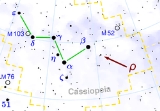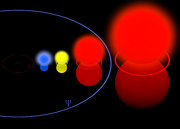
Rho Cassiopeiae
Encyclopedia
Rho Cassiopeiae (icon; ρ Cas, ρ Cassiopeiae) is a yellow hypergiant
star in the constellation Cassiopeia
. It is about 11650 ly away from Earth, yet can still be seen by the naked eye (in the Northern Hemisphere
only), as it is 550,000 times as luminous
as the Sun
. On average, it has an absolute magnitude
of −7.5, making it one of the most luminous stars known. Its surface diameter measures 450 times that of the Sun, or approximately 630,000,000 kilometers. Being a yellow hypergiant, it is one of the rarest types of stars, one of only seven in the Milky Way
that are currently known, though it is not the only one in its constellation, which also includes V509 Cassiopeiae
. Rho Cassiopeiae is a single star, and is categorized as a semiregular variable
.
 The Bayer designation
The Bayer designation
for this star was established in 1603 as part of the Uranometria
, a star catalog produced by Johann Bayer
. The star catalog by John Flamsteed
published in 1712, which orders the stars in each constellation by their right ascension
, gave this star the Flamsteed designation
7 Cassiopeiae.
Rho Cassiopeiae is somewhat unstable in its luminosity. Its apparent magnitude
is currently about 4.5. In 1946 it dimmed to 6th magnitude and cooled approximately 4000 Kelvin, before returning to its previous brightness. A similar eruption was recorded in 1893, suggesting that it undergoes these eruptions approximately once every 50 years. This happened again in 2000–2001, when it produced one of the largest outbursts known, ejecting approximately 10,000 Earth mass
es, or about 3% of a solar mass
. During the summer of 2000 it was observed (by the William Herschel Telescope
) to have cooled from 7,000 to 4,000 Kelvin in the course of a few months.
These observations have also shown evidence that Rho Cassiopeiae may have already become a supernova
(though the light from the explosion has not yet reached us), or will in the near future, because it has consumed most of its nuclear fuel. Assuming its eruptions have continued to occur at the same rate as those observed recently, the star will have lost approximately 20 solar masses over 10,000 years.
Yellow hypergiant
Generally speaking, a yellow hypergiant is a massive star with an extended atmosphere, which can be classified as spectral class from late A to K, with a mass of as much as 20-50 solar masses...
star in the constellation Cassiopeia
Cassiopeia (constellation)
Cassiopeia is a constellation in the northern sky, named after the vain queen Cassiopeia in Greek mythology, who boasted about her unrivalled beauty. Cassiopea was one of the 48 constellations listed by the 2nd century Greek astronomer Ptolemy, and it remains one of the 88 modern constellations today...
. It is about 11650 ly away from Earth, yet can still be seen by the naked eye (in the Northern Hemisphere
Northern Hemisphere
The Northern Hemisphere is the half of a planet that is north of its equator—the word hemisphere literally means “half sphere”. It is also that half of the celestial sphere north of the celestial equator...
only), as it is 550,000 times as luminous
Luminosity
Luminosity is a measurement of brightness.-In photometry and color imaging:In photometry, luminosity is sometimes incorrectly used to refer to luminance, which is the density of luminous intensity in a given direction. The SI unit for luminance is candela per square metre.The luminosity function...
as the Sun
Sun
The Sun is the star at the center of the Solar System. It is almost perfectly spherical and consists of hot plasma interwoven with magnetic fields...
. On average, it has an absolute magnitude
Absolute magnitude
Absolute magnitude is the measure of a celestial object's intrinsic brightness. it is also the apparent magnitude a star would have if it were 32.6 light years away from Earth...
of −7.5, making it one of the most luminous stars known. Its surface diameter measures 450 times that of the Sun, or approximately 630,000,000 kilometers. Being a yellow hypergiant, it is one of the rarest types of stars, one of only seven in the Milky Way
Milky Way
The Milky Way is the galaxy that contains the Solar System. This name derives from its appearance as a dim un-resolved "milky" glowing band arching across the night sky...
that are currently known, though it is not the only one in its constellation, which also includes V509 Cassiopeiae
V509 Cassiopeiae
V509 Cassiopeiae is a star in the constellation Cassiopeia.V509 Cassiopeiae is a yellow-white G-type hypergiant with a mean apparent magnitude of +5.10. It is at least 7800 light years from Earth. It is classified as a semiregular variable star and its brightness varies from magnitude +4.75 to...
. Rho Cassiopeiae is a single star, and is categorized as a semiregular variable
Semiregular variable star
Semiregular variable stars are giants or supergiants of intermediate and late spectral type showing considerable periodicity in their light changes, accompanied or sometimes interrupted by various irregularities. Periods lie in the range from 20 to more than 2000 days, while the shapes of the light...
.
Observation

Bayer designation
A Bayer designation is a stellar designation in which a specific star is identified by a Greek letter, followed by the genitive form of its parent constellation's Latin name...
for this star was established in 1603 as part of the Uranometria
Uranometria
Uranometria is the short title of a star atlas produced by Johann Bayer.It was published in Augsburg, Germany, in 1603 by Christophorus Mangus under the full title Uranometria : omnium asterismorum continens schemata, nova methodo delineata, aereis laminis expressa. This translates to...
, a star catalog produced by Johann Bayer
Johann Bayer
Johann Bayer was a German lawyer and uranographer . He was born in Rain, Bavaria, in 1572. He began his study of philosophy in Ingolstadt in 1592, and moved later to Augsburg to begin work as a lawyer. He grew interested in astronomy during his time in Augsburg...
. The star catalog by John Flamsteed
John Flamsteed
Sir John Flamsteed FRS was an English astronomer and the first Astronomer Royal. He catalogued over 3000 stars.- Life :Flamsteed was born in Denby, Derbyshire, England, the only son of Stephen Flamsteed...
published in 1712, which orders the stars in each constellation by their right ascension
Right ascension
Right ascension is the astronomical term for one of the two coordinates of a point on the celestial sphere when using the equatorial coordinate system. The other coordinate is the declination.-Explanation:...
, gave this star the Flamsteed designation
Flamsteed designation
Flamsteed designations for stars are similar to Bayer designations, except that they use numbers instead of Greek letters. Each star is assigned a number and the Latin genitive of the constellation it lies in...
7 Cassiopeiae.
Rho Cassiopeiae is somewhat unstable in its luminosity. Its apparent magnitude
Apparent magnitude
The apparent magnitude of a celestial body is a measure of its brightness as seen by an observer on Earth, adjusted to the value it would have in the absence of the atmosphere...
is currently about 4.5. In 1946 it dimmed to 6th magnitude and cooled approximately 4000 Kelvin, before returning to its previous brightness. A similar eruption was recorded in 1893, suggesting that it undergoes these eruptions approximately once every 50 years. This happened again in 2000–2001, when it produced one of the largest outbursts known, ejecting approximately 10,000 Earth mass
Earth mass
Earth mass is the unit of mass equal to that of the Earth. 1 M⊕ = 5.9722 × 1024 kg. Earth mass is often used to describe masses of rocky terrestrial planets....
es, or about 3% of a solar mass
Solar mass
The solar mass , , is a standard unit of mass in astronomy, used to indicate the masses of other stars and galaxies...
. During the summer of 2000 it was observed (by the William Herschel Telescope
William Herschel Telescope
The William Herschel Telescope is a optical/near-infrared reflecting telescope located at the Observatorio del Roque de los Muchachos on the island of La Palma in the Canary Islands, Spain. The telescope, which is named after William Herschel, is part of the Isaac Newton Group of Telescopes...
) to have cooled from 7,000 to 4,000 Kelvin in the course of a few months.
These observations have also shown evidence that Rho Cassiopeiae may have already become a supernova
Supernova
A supernova is a stellar explosion that is more energetic than a nova. It is pronounced with the plural supernovae or supernovas. Supernovae are extremely luminous and cause a burst of radiation that often briefly outshines an entire galaxy, before fading from view over several weeks or months...
(though the light from the explosion has not yet reached us), or will in the near future, because it has consumed most of its nuclear fuel. Assuming its eruptions have continued to occur at the same rate as those observed recently, the star will have lost approximately 20 solar masses over 10,000 years.

